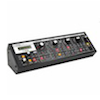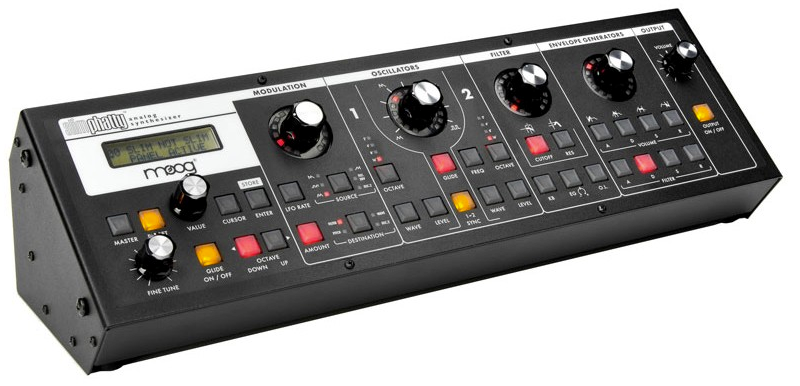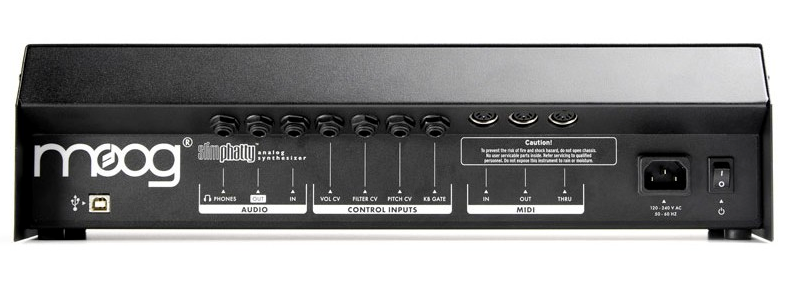MOOG SLIM PHATTY REVIEW
Posted on Tue 11 September 2012 in entries
 You can read more reviews like this, listen to Tony’s productions, purchase synth patches and more at his personal site -> Tony Long Music.
You can read more reviews like this, listen to Tony’s productions, purchase synth patches and more at his personal site -> Tony Long Music.
MOOG SLIM PHATTY - INTRODUCTION
Are you up for some analogue synth sounds - I mean 100% analogue? Well I have got my hands on the Moog Slim Phatty, which is a single voice 100% analogue subtractive synthesiser. In terms of big names in synthesisers, you do not get any bigger than Moog...
As you probably know, the very last thing Bob Moog worked on was the Little Phatty synth. Whilst it still had that classic Moog sound, it also had some up-to-date additions, one of which was USB connectivity. The legacy he left behind in synth design has led to the release of a smaller rack-mounted synth module, aptly named the Moog Slim Phatty.
With its compact design, the Moog Slim Phatty will sit nicely in almost any studio - you can place it on your desk on its four rubber feet or you can purchase a rack-ear kit. It is very solidly built with a metal casing and as you turn it on it has plenty of status light indicators. If you don't wish to rack-mount it, you can also buy wooden end-cheeks to give it even more of a vintage look, but that's only for if you're feeling flash!
Personally, I like it just as it is, so I shall power it up, start to get to grips with the layout and (hopefully) start making some awesome sounds!
MOOG SLIM PHATTY - LAYOUT, SIZE AND WEIGHT
The layout is almost identical to the Little Phatty keyboard. It has 34 buttons and 7 knobs and it is divided into 6 main areas comprising of: (1) the LCD and User section, (2) the modulation section, (3) the oscillator section, (4) the filter section, (5) the envelope generators and (6) the output section.
The Slim Phatty has four very sturdy rotary pots with bright red 15 point LED indicators to show you where you are. Under each of these is a very user friendly editing system, whereby you simply press the desired button and the rotary pot will control that aspect of the synth - brilliant.
The size of the Slim Phatty is 43.2 x 11.6 x 13.5 cm and its weight is a solid 2.6 kg.
MOOG SLIM PHATTY - SECTION 1 - THE USER INTERFACE AND LCD
Within its first section, the Slim Phatty has something called 'Master mode', which is accessible via the touch of a button. This basically takes you into all of the global settings and the Advanced Preset settings for the Slim Phatty. In Master mode you will also find the routines for the sending and receiving of data.
The Slim Phatty contains eleven Advanced Preset menus for: Filter Poles, EGR release, Gate Trigger Options, Filter Sensitivity, Additional LFO Modulation Sources for (SRC5 & SRC6), Pitch Bend, Secondary Modulation destinations, Keyboard Priority, Pot Mapping and the Arpeggiator.
Next to the Master button is a preset button, which allows you to select from the Slim Phatty's 100 presets in combination with the Value dial and Cursor and Store buttons. It's all very user friendly.
Under this you have a Fine Tune dial, which is very sensitive (and can be turned off if you so wish), a Glide On/Off button and Down and Up Octave buttons that cover four octaves. Although it's a simple idea, I really like the LED feedback for the octave buttons; they glow red when you go up or down one octave and orange when you go up or down two octaves.
The LCD itself is a monochrome, backlit 16 x 2 character display and I found this to be generally ok working in conjunction with the user interface. There is a little bit of a learning curve to it, but you soon settle down to its ways.
MOOG SLIM PHATTY - SECTION 2 - THE MODULATION SECTION
Another one of my favourite features of the Slim Phatty is the programmable modulation matrix. This is where you can really add life to your sounds as it provides for endless permutations of tonal possibilities. On the Slim Phatty, you can choose from six modulation sources and four destinations and you can of course also dial in the amount of modulation that you want. The sources that the Slim Phatty provides for you to select from are: LFO Triangle, LFO Square, LFO Sawtooth, LFO Ramp, Filter Envelope/Sample and Hold, and Oscillator 2/Noise.
The destinations are Filter (which affects the filter cutoff), Pitch (which affects the pitch of both oscillators), Wave (which affects the waveform of both oscillators) and Osc 2 (which affects the pitch of Oscillator 2).
The modulation section has four buttons (LFO Rate, Source, Amount and Destination) and a control knob, which controls either the LFO rate or the mod depth. Pressing and holding the 'Amount' switch enables the modulation control knob to act as a mod wheel.
MOOG SLIM PHATTY - SECTION 3 - THE OSCILLATORS SECTION
The Slim Phatty has two identical oscillators, which are continuously variable. I love the way they very smoothly take you through the different waveforms, allowing you to select shapes that lie somewhere inbetween two different waveforms for even more tonal possibilities. There are four waveforms to select from for each oscillator; Sawtooth, Pulse, Triangle and Square. Once you have selected your waveforms the fun really begins as you can start to tune them separately to fatten the sound, or sync them for that classic synced sound!
http://www.youtube.com/watch?v=9z0FQ9HmPKI
MOOG SLIM PHATTY - SECTION 4 - THE FILTER SECTION
The Slim Phatty's mono filter section has that lovely Moog 24dB/Octave 'ladder filter', which is very smooth. It is only a low-pass filter but it can self-resonate. The filter section has further controls so that you can adjust the cutoff frequency, resonance, keyboard amount and envelope amount. However, my favourite part of the filter section is the 'Overload Level' control, which allows you to get really mean and dirty by adding some fantastic distortion. From this section the sound goes to the output voltage controlled amplifier, which is controlled in Section 5 by the Volume Envelope Generator.
MOOG SLIM PHATTY - SECTION 5 - THE ENVELOPE GENERATORS
The Slim Phatty has two envelope generators with eight buttons arranged in two banks of four. One bank controls Attack, Decay, Sustain and Release (ADSR) for the amplifier (volume) and the other controls ADSR for the Filters (to control the cutoff frequency). The filter envelope generator can also be used as a modulation source through the modulation matrix.
MOOG SLIM PHATTY - SECTION 6 - THE OUTPUT SECTION
There is not much to say here as this is the smallest of the sections with just a Volume knob and an Output On/Off button. The Volume control simultaneously adjusts the level of both the monophonic audio output and the headphone output. The idea behind the Output On/Off button is to allow you to turn off the main audio output but keep your headphone signal going.
MOOG SLIM PHATTY - PRESETS
Listening to the presets on any synth is always an interesting experience. It seems very strange to me (and I am sure I have said this before), but if I were a manufacturer of a new synth and I was desperately trying to sell my product and get the public to part with their hard earned cash, then an area that I would pay particular attention to would be the presets. I would want the person auditioning it to experience that 'wow' factor as they played their first sound. However, over my years of testing out equipment, this has only happened to me a couple of times. The first was in a music shop where I played two chords (Gm7 and Dm7) on a Yamaha DX7. As I held the chords down I felt the whole shop go quiet and everyone gazed at me as if I had played the best thing they had ever heard! The second was when I first heard the Novation Supernova II. However, it seems today, this just doesn't happen and we all talk of a synth's potential rather than what it can immediately do.
This is not to say that the Phatty's presets are not good, it's just that for me they do not have that 'wow' factor. The annoying part is that, after using it for a short time, you discover what it is capable of and this makes you wonder even more why the presets are not mind-blowingly awesome in the first place! However, if nothing else it motivates you to get editing and come up with something better - which after all is what it is all about.
MOOG SLIM PHATTY - ARPPEGIATOR AND OTHER HIDDEN GEMS
I must admit that I struggled to find the arpeggiator, even on this user-friendly layout; I was expecting an Arp button on the front panel but it wasn't there! Instead, to activate the arpeggiator you need to press down on the Value knob in Preset mode. As you do this, an 'A' will appear on the LCD and you can latch the arpeggiator by pressing the 'Enter' button, which causes an 'L' to be displayed on the screen. If you want to adjust the tempo as you are playing, just turn the Modulation control. If you want a finer adjustment you can use the Value knob. It's just a matter of getting familiar with this way of working.
The other arpeggiator parameters are available in the Advanced Preset menu. Here you can set the arpeggiator pattern - choose from 'Up', 'Down' or in the 'order that you play'.You can also decide whether the clock should be internal or sync over USB to the tempo of your DAW. There are seven pages for the arpeggiator so I think it is a shame there is not a dedicated Arp section on the front panel.
I know I have briefly mentioned the Advanced Preset menu, but this is actually at the heart of the Slim Phatty, so it's worth mentioning it some more! What I like about it is that it has options for you to change the settings for individual presets rather than change the global settings. For example, you can select filter cutoff slopes of 6dB/oct, 12dB/oct, 18dB/oct or 24dB/oct on a 'per patch' basis. You can also set up alternate tunings for each patch, which is something you will not find on other mono analogue synths.
Something also worth looking at is the Gate menu. Here you can select from three options; Legato On, Legato Off and EGR Reset. With 'Legato On' you will find that it will not retrigger the envelope until you have released the key. 'Legato Off' on the other hand allows you to retrigger successive notes from the current envelope value rather than at zero (I really like this option), and finally 'EGR Reset' will retrigger the envelope with every note you play, regardless of whether you've released the previous key.
Something else that is not obvious without referring to the manual is that the Slim Phatty has a Performance mode, which is especially great for live use. Performance mode allows you to create four banks of up to eight presets and then step through them in order (by turning the Value knob), regardless of where they are in the storage area of the 100 memory patches.
I have also just found something called 'Precision mode'. Apparently here you can carry out precise editing of parameters using the Value knob. Each parameter stored has a value from 0 to 4095 and this value is shown on the second line on the screen.
MOOG SLIM PHATTY - CONNECTIONS
Around the back of the Slim Phatty you have the power supply and an On/Off switch. This isn't a particularly good place to have an On/Off switch if you rack-mount it, so you might need to give that some thought. The power connection is a standard IEC three-prong 120-240 Volt AC supply, which is far better than a wall-wart. The other good point about the power supply is that you can adjust the voltage to match the country you are in.
The Slim Phatty also has MIDI In, Out and Thru, four 1/4 inch jack Control inputs (KB Gate, Pitch Control Voltage, Filter Control Voltage, Volume Control Voltage) to control the Slim Phatty from other analogue equipment, a Mono Audio input, Mono Audio Output, Headphone output and a USB 2.0 connection for interfacing with a software DAW. Obviously the headphone socket is also not in an ideal place if you decide to rack-mount it.
MOOG SLIM PHATTY - CONCLUSION
The Moog Slim Phatty gives you a lot of dirt, grunge and distortion and what you can achieve from its basic arpeggiator is really 2012! I love the way you get some sounds that sound up-to-date in a retro way!
The Slim Phatty is amongst one of the cheapest ways you can add an analogue Moog synth to your arsenal of instruments. When you consider that the Slim Phatty gives you the same sound engine as the Little Phatty at approximately £400 less, it is a great purchase. It is a shame that noise is not available as a sound source and I really can't believe they put the On/Off switch and the headphone socket at the back but the positives really knock the few minor niggles for six.
The Slim Phatty is a wicked analogue synth with USB and Control-Voltage inputs. It is extremely fun to play around with, especially the filter (which has a great range) and the arpeggiator. You get some good factory presets (and Performance Preset Banks) to start you off but this baby is about sound creation in true analogue tradition. It is extremely user-friendly, so there is no excuse for not getting straight in there and creating some dirty provocative sounds that have all that warmth you expect from a quality Moog product.
For more information on the Moog Slim Phatty, or the Little Phatty (the keyboard version), click the links below or give us a call on 01202 597180.
Moog Slim Phatty - More Info/Buy
Moog Little Phatty - More Info/Buy
Moog Slim Phatty Rack Ears - More Info/Buy
******If you're interested in buying and you have seen it cheaper elsewhere, please call us or use our
As well as receiving our first rate customer service you can also claim money off your next purchase with our loyalty points scheme and receive a 3 year warranty if you sign up to our FREE VIP Club (click here for more infomation). Many of our items also come out on a FREE next-day delivery service to mainland UK customers, so you won't be left waiting!
Also, if you want to keep up with all our latest offers, competitions, news and videos, why not follow us on Facebook and Twitter?

